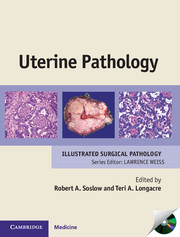Book contents
- Frontmatter
- Contents
- List of contributors
- Preface
- Acknowledgments
- 1 Cytology of the uterine cervix and corpus
- 2 Cervix: squamous cell carcinoma and precursors
- 3 Cervix: adenocarcinoma and precursors, including variants
- 4 Miscellaneous cervical abnormalities
- 5 Non-neoplastic endometrium
- 6 Endometrial carcinoma precursors: hyperplasia and endometrial intraepithelial neoplasia
- 7 Endometrioid adenocarcinoma
- 8 Serous adenocarcinoma
- 9 Clear cell adenocarcinoma and other uterine corpus carcinomas, including unusual variants
- 10 Carcinosarcoma
- 11 Adenofibroma and adenosarcoma
- 12 Uterine smooth muscle tumors
- 13 Endometrial stromal tumors
- 14 Other uterine mesenchymal tumors
- 15 Miscellaneous primary uterine tumors
- 16 Uterine metastases: cervix and corpus
- 17 Gestational trophoblastic disease
- 18 Other pregnancy-related abnormalities
- 19 Lynch syndrome (hereditary non-polyposis colorectal cancer syndrome)
- 20 Cytology of peritoneum and abdominal washings
- Index
- References
20 - Cytology of peritoneum and abdominal washings
Published online by Cambridge University Press: 05 July 2013
- Frontmatter
- Contents
- List of contributors
- Preface
- Acknowledgments
- 1 Cytology of the uterine cervix and corpus
- 2 Cervix: squamous cell carcinoma and precursors
- 3 Cervix: adenocarcinoma and precursors, including variants
- 4 Miscellaneous cervical abnormalities
- 5 Non-neoplastic endometrium
- 6 Endometrial carcinoma precursors: hyperplasia and endometrial intraepithelial neoplasia
- 7 Endometrioid adenocarcinoma
- 8 Serous adenocarcinoma
- 9 Clear cell adenocarcinoma and other uterine corpus carcinomas, including unusual variants
- 10 Carcinosarcoma
- 11 Adenofibroma and adenosarcoma
- 12 Uterine smooth muscle tumors
- 13 Endometrial stromal tumors
- 14 Other uterine mesenchymal tumors
- 15 Miscellaneous primary uterine tumors
- 16 Uterine metastases: cervix and corpus
- 17 Gestational trophoblastic disease
- 18 Other pregnancy-related abnormalities
- 19 Lynch syndrome (hereditary non-polyposis colorectal cancer syndrome)
- 20 Cytology of peritoneum and abdominal washings
- Index
- References
Summary
INTRODUCTION
Peritoneal wash cytology has classically been used during exploratory laparotomy to detect occult serosal involvement by a neoplastic process or to demonstrate persistent or recurrent malignancy. In the past, peritoneal wash cytology has had significant therapeutic and prognostic impact, especially for ovarian and endometrial carcinomas. The current FIGO recommendations have eliminated the results of cytologic evaluation of peritoneal washing specimens from the staging criteria for endometrial carcinoma, which de-emphasizes the role of wash cytology in uterine corpus cancer. This change is based on the long-observed undetermined clinical significance of isolated positive peritoneal wash cytology in low-grade, organ-confined endometrial carcinoma (previously considered FIGO stage IIIA). In addition, a positive wash cytology does not correlate with the histologic subtype of endometrial carcinoma, grade, depth of invasion, or the presence of vascular invasion. Positive peritoneal wash cytology does impact survival, but only if other adverse prognostic factors are present. Despite the updated recommendations, continued collection of cytology may provide useful information for making postoperative treatment decisions or in future research studies. The clinical significance of positive wash cytology for cervical carcinoma is less clear. Since we continue to receive peritoneal wash specimens on some patients with corpus cancer either during a staging or exploratory procedure for suspected gynecologic malignancy of unknown primary site, the discussion in this chapter focuses on the interpretation of these specimens.
- Type
- Chapter
- Information
- Uterine Pathology , pp. 341 - 348Publisher: Cambridge University PressPrint publication year: 2012



